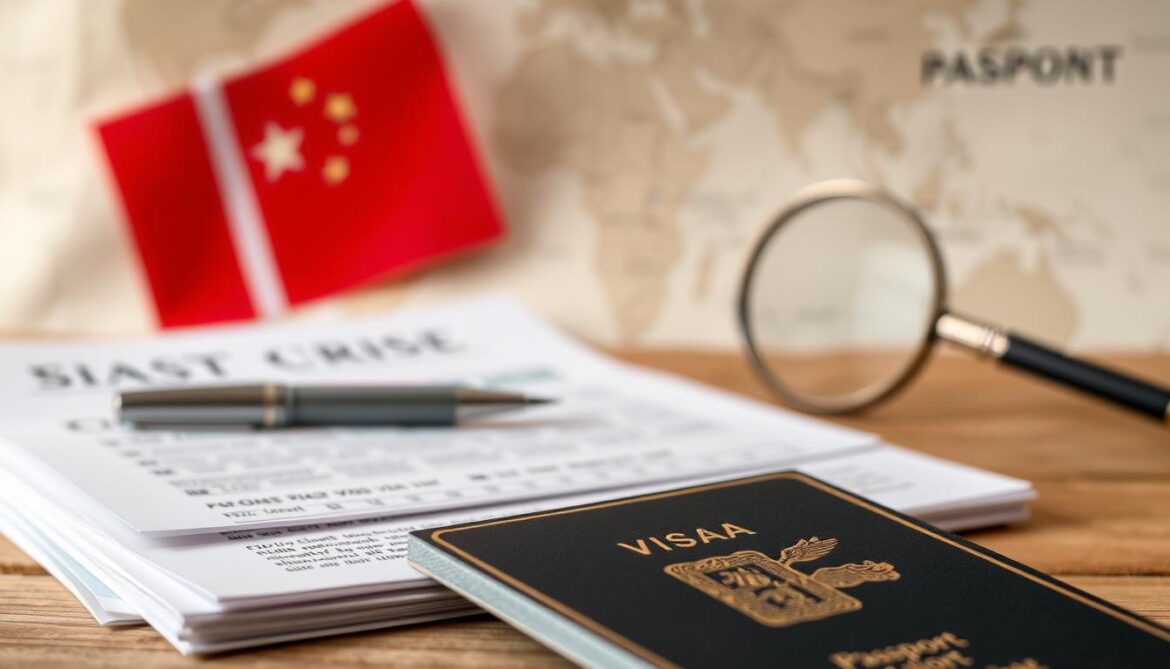Did you know over 700,000 Canadians visited China last year? With its rich history and booming tourism, it’s no surprise more travelers are planning their trips. If you’re among them, securing the right documents is your first step.
This guide simplifies the process for Canadian residents. Whether you’re applying in person or by mail, we cover everything from forms to processing times. Five service centers across Canada handle submissions, including Vancouver, Toronto, and Montreal.
Start early—experts recommend beginning 1-3 months before your travel dates. You’ll need a valid passport, photos, and proof of residency. The official China Visa Application Service Center website provides real-time updates for tracking.
Preparing correctly saves time and avoids delays. Let’s explore how to meet all requirements smoothly.
Understanding the Chinese Visa Application Process
Planning a trip to China starts with understanding entry rules. Most Canadian citizens need authorization, though exceptions exist for transit stops or diplomatic cases. Check your passport type and travel purpose to confirm requirements.
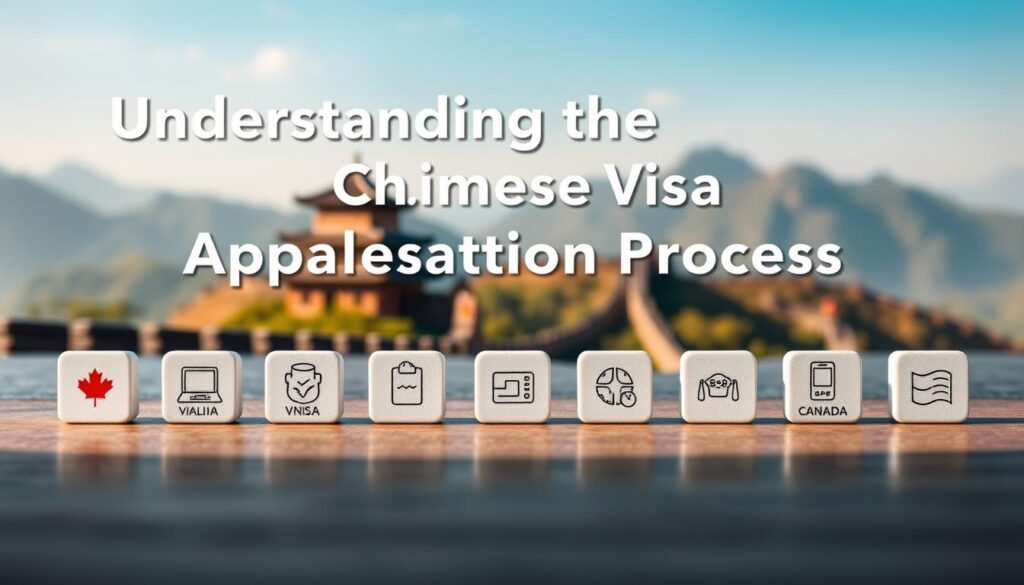
Who Needs a Visa for China?
All Canadian passport holders must apply unless qualifying for visa-free transit. Short layovers (24–144 hours) may not need approval, but longer stays do. Cruise passengers have separate rules—verify with your cruise line.
British Columbia residents must submit documents through Vancouver’s center. Those with diplomatic or official passports might bypass standard procedures.
Types of Visas Available for Canadian Residents
China offers six main categories:
- Tourist (L): For sightseeing or family visits.
- Business (M): Meetings, conferences, or trade.
- Work (Z): Employment with a Chinese sponsor.
- Student (X): Long-term academic programs.
Frequent travelers could qualify for a 10-year validity option, reducing repeat applications. Always confirm current rules, as policies adjust periodically.
Eligibility Criteria for Canadian Applicants
Before packing your bags for China, confirm you meet all entry criteria. Your documents must align with current rules to avoid delays. Key factors include passport validity, residency proof, and special circumstances like minors or former PRC nationals.
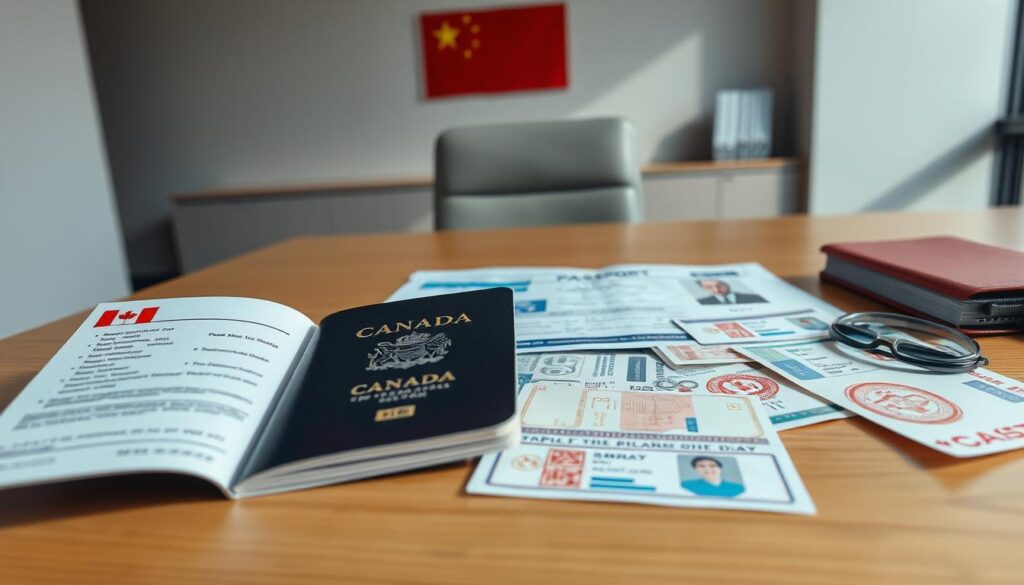
Residency and Passport Requirements
Your passport must have:
- At least 6 months validity beyond your travel dates.
- Two blank pages (unstamped) for entry/exit stamps.
British Columbia residents can prove residence with a driver’s license or utility bill. Dual citizens should standardize names across documents.
Special Cases: Minors and Former PRC Nationals
For travelers under 18:
- Submit a notarized parental consent letter.
- Include a birth certificate copy.
Former PRC nationals must provide their old Chinese passport. NGO workers or military personnel may face additional scrutiny.
Required Documents for Your Chinese Visa Application
Gathering the right paperwork is crucial for hassle-free entry to China. Missing even one item could delay your plans. Below, we break down each requirement for clarity.
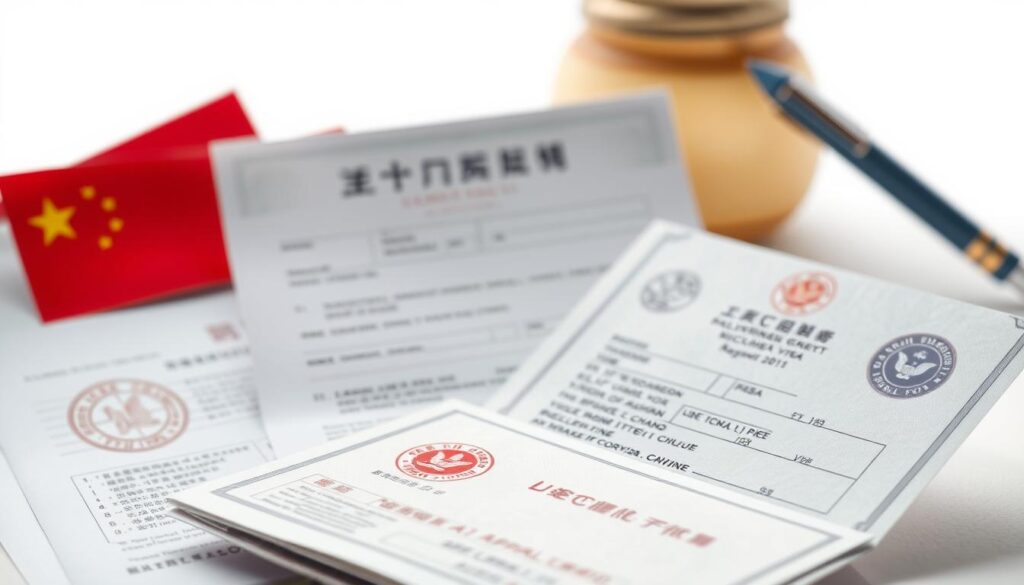
Passport Specifications: Validity and Blank Pages
Your passport must have 6 months validity beyond your trip dates. Ensure it has two blank pages for stamps. Damaged or altered passports may lead to rejection.
Passport Photo Guidelines
Follow these specs for your photo to avoid delays:
| Requirement | Details |
|---|---|
| Size | 48mm x 33mm |
| Background | Plain white |
| Attire | No glasses or headwear (religious exemptions apply) |
*Digital submissions are accepted but must meet the same standards.
Proof of Legal Status in Canada
Non-citizens need a valid residency permit. Acceptable proofs include:
- Driver’s license (provincial)
- Utility bill (dated within 3 months)
Supporting Documents for Travel History
Declare all trips in the last 28 days. Use this template:
Date | Country | Purpose of Stay
Foreign documents may need notarization. Disclose any criminal records if asked.
How to Complete the Chinese Visa Application Form
Accuracy in your paperwork ensures a hassle-free approval process. The application form requires careful attention to detail. Mistakes can lead to delays or rejections.
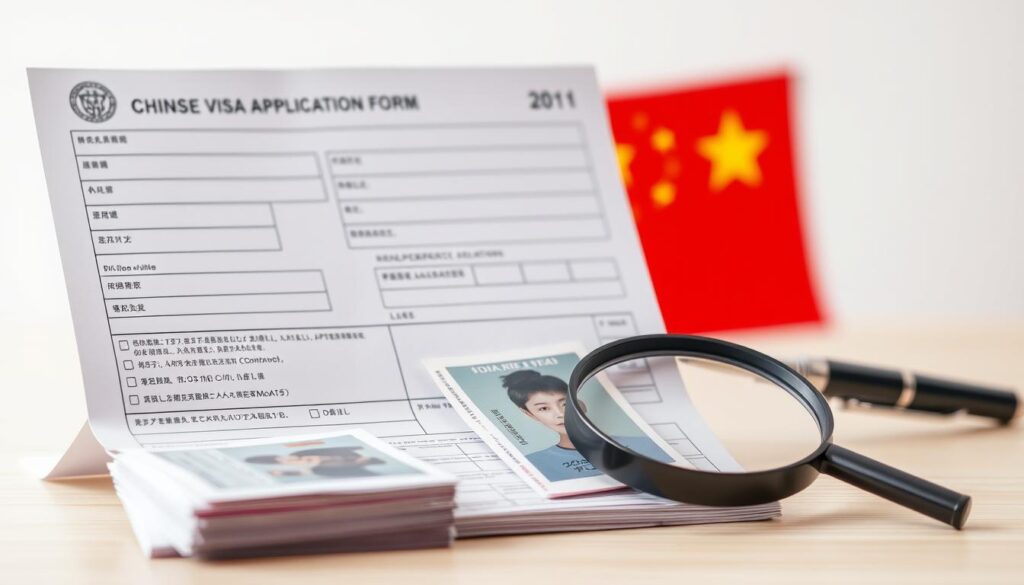
Online Form vs. Handwritten Submissions
All submissions must start with the online form. Handwritten entries are no longer accepted. Follow these steps:
- Use the official portal to fill out the visa application form.
- Sign in blue or black ink—no digital signatures.
- Print single-sided on plain white paper.
Common Mistakes to Avoid
Errors often occur in these sections:
| Section | Pitfall | Solution |
|---|---|---|
| Employment History | Missing employer contact | Include phone/email |
| Name | Mismatched passport spelling | Copy exactly |
| Travel Dates | Conflicting with flight itineraries | Double-check alignment |
Former nationals must enter their Chinese characters in the designated field. Parents signing for minors need notarized consent.
Booking Travel and Accommodation for Your Visa
Locking in your itinerary details is a critical step before submission. Authorities require proof of your travel plans to verify entry and exit dates. Missing or mismatched documents can delay processing.

Confirmed Flight Itinerary Requirements
Your trip must include round-trip tickets with matching visa dates. Airlines provide reservation templates if tickets aren’t yet purchased. Cruise passengers should specify docking cities.
Group tours need a detailed itinerary from the organizer. COVID-era policies may allow flexible rebooking—check current rules before finalizing.
Accommodation Proof: Hotels vs. Invitation Letters
Choose between two options:
| Option | Requirements |
|---|---|
| Hotel Bookings | Confirmed reservations covering all stay dates |
| Invitation Letter | Notarized copy + host’s ID for personal stays |
Business travelers may substitute letters from sponsoring companies. Ensure all documents are in English or Chinese to avoid translation delays.
Visa Fees and Processing Times
Understanding costs and timelines helps you budget wisely for your trip. Fees and wait times depend on your travel purpose and urgency. Below, we break down the latest rates and options to expedite approval.
Cost Breakdown by Visa Type
Current fees (2023) vary by category. Provincial taxes may apply, and postal submissions incur a $20 surcharge. Here’s a comparison:
| Type | Standard Fee (CAD) | Express Fee (CAD) |
|---|---|---|
| Tourist (L) | $140 | $210 |
| Business (M) | $150 | $225 |
| Student (X) | $125 | $187.50 |
*Express service costs 50% more. Payment is credit/debit only—no cash or cheques.
Expedited Processing Options
Standard processing takes 4–10 business days. Need it faster? Opt for express service, which cuts the time by half. Note:
- Peak seasons (e.g., summer months) may delay approvals.
- Denied applications are non-refundable, so double-check documents.
Submit at any service center or by mail. Track your status online for real-time updates.
Submitting Your Application in Canada
Choosing the right submission method saves time and hassle. Canada offers two options: in-person or postal delivery. Each has unique advantages depending on your schedule and location.
In-Person vs. Postal Submission
Visiting a service center lets you verify documents instantly. Staff can flag missing items before you leave. Postal kits work for remote applicants but require prepaid return labels.
| Method | Pros | Cons |
|---|---|---|
| In-Person | Immediate document checks | Travel required |
| Postal | No travel needed | Slower processing |
Courier partners like FedEx offer tracking for mailed applications. Translation services are available for non-English documents—factor these into your timeline.
Appointment Booking at Visa Centers
All in-person visits need appointments via the Canada visa portal. Follow these steps:
- Log in and select your nearest service center.
- Upload documents for pre-checking (optional but recommended).
- Choose a slot—peak times fill fast.
Biometrics aren’t required for most applicants. If needed, you’ll get instructions after submitting. Double-check your confirmation email for entry requirements.
Visa-Free Entry and Exceptions
Not all trips to China require advance paperwork—know the exceptions. Certain travelers can enter without prior approval if they meet requirements for short stays or special programs. Always verify current rules, as policies shift periodically.
Scenarios Qualifying for Visa-Free Travel
Canada passport holders may bypass standard processes in these cases:
- Transit stops: 24–144-hour layovers at approved airports (e.g., Beijing, Shanghai).
- APEC Business Travel Card: Holders enjoy streamlined entry for work trips.
- Special regions: Macau or Hong Kong visits often have separate rules.
COVID-era adjustments may affect eligibility. Confirm with your airline or embassy before departure.
Documentation Still Required
Even for visa-free entry, you’ll need:
| Requirement | Details |
|---|---|
| Onward Ticket | Proof of a connecting flight within the allowed timeframe |
| Passport Validity | 6+ months remaining |
| Accommodation Proof | Hotel booking or host invitation |
Note: Transit exemptions don’t apply if leaving the airport. Always double-check with your trip china itinerary.
Post-Submission Steps
Once you’ve submitted your documents, the next steps ensure smooth processing. Stay proactive to avoid delays and errors. Here’s how to track progress and collect your approved paperwork.
Tracking Your Application Status
Use the official portal to monitor your submission in real time. You’ll receive SMS or email alerts for updates. Common milestones include:
- Received: Documents are under review.
- Processing: Approval is underway.
- Ready for Collection: Visit the center or await delivery.
Misplaced your reference number? Contact the service center with your passport copy for assistance.
Collecting Your Visa and Verifying Details
Upon approval, double-check all pages for accuracy. Errors in dates or personal details must be reported within 72 hours. Bring these to collect your documents:
| Requirement | Notes |
|---|---|
| Receipt | Original submission proof |
| ID | Passport or residency card |
| Authorization Letter | If someone collects for you |
Tip: Emergency corrections may incur fees. Review all stamps and signatures before leaving the center.
Tips for a Smooth Chinese Visa Application
Streamlining your paperwork can make all the difference for stress-free travel. Small oversights often cause delays, but these strategies help you stay ahead.
Double-Checking Document Compliance
Use this checklist to ensure alignment with requirements:
- Passport copies: Clear, unaltered scans matching originals.
- Travel insurance: Some agencies recommend tying it to your application.
- Translation cards: Certified services for non-English documents.
“Pre-check services ($25–50) spot errors before submission—worth the investment for complex cases.”
Third-Party Services: Pros and Cons
Registered agencies save time but require vetting. Watch for these red flags:
| Service Type | Advantages | Risks |
|---|---|---|
| Pre-Check | Error detection | Added fees |
| Full Submission | Handles paperwork | Scams (verify registration) |
For peace of mind, confirm an agency’s license with the China Visa Application Service Center. Legitimate providers share tracking information transparently.
Conclusion
A few extra steps ensure your trip goes smoothly from start to finish. Consider travel insurance for unexpected delays or health needs. It’s a small cost for big peace of mind.
Learn basic Mandarin phrases or download translation apps. Locals appreciate the effort, and it eases navigation. Register with Canada’s embassy abroad for safety alerts.
Pack photocopies of your passport and china visa. Keep them separate from originals. Grab a local SIM card upon arrival for affordable data.
Final tip? Review your checklist 30 days before departure. Confirm flights, accommodations, and document expiry dates. Now, you’re set for an unforgettable journey!


